Description
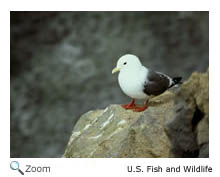 The red-legged kittiwake is a small gull that is 13-18 inches in length. It has white undersides, chest, and head; dark gray upperwings and back; and black tips on its wings. It has a slightly forked white tail, a bright yellow bill, red legs, and webbed feet with three toes. The name kittiwake comes from its call. Males and females look alike. The red-legged kittiwake is a small gull that is 13-18 inches in length. It has white undersides, chest, and head; dark gray upperwings and back; and black tips on its wings. It has a slightly forked white tail, a bright yellow bill, red legs, and webbed feet with three toes. The name kittiwake comes from its call. Males and females look alike.
Range 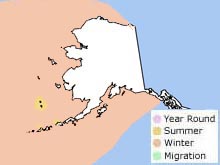 The red-legged kittiwake breeds in Alaska on the
Pribilof Islands, Bogoslof Islands, and Buldir Island, and on Russia's Commander Islands. It winters on the North Pacific Ocean. The red-legged kittiwake breeds in Alaska on the
Pribilof Islands, Bogoslof Islands, and Buldir Island, and on Russia's Commander Islands. It winters on the North Pacific Ocean.
Habitat
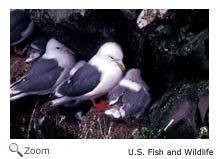 The red-legged kittiwake is found on sea cliffs and ledges during breeding season. It winters on the open ocean. The red-legged kittiwake is found on sea cliffs and ledges during breeding season. It winters on the open ocean. | |
Diet
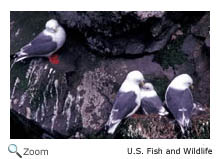 The red-legged kittiwake eats
small fish, squid, zooplankton, and plankton. It feeds in flocks and catches food at the surface of the water. It also dives just below the surface of the water to catch its prey. The red-legged kittiwake eats
small fish, squid, zooplankton, and plankton. It feeds in flocks and catches food at the surface of the water. It also dives just below the surface of the water to catch its prey.
Life Cycle
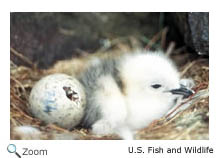 The red-legged kittiwake nests in huge colonies that can include thousands of birds. The red-legged kittiwake male returns to the same nesting site year-after-year. Male and female pairs may mate for more than one season. The nest is cup-shaped and made of moss, seaweed, and mud. The nest is placed on the top or side of a cliff or ledge. The female lays 1-3 eggs. The male and female both incubate the eggs. The chicks hatch in about 27 days. Both parents care for and feed the chicks. The chicks fledge when the are about 40 days old. The red-legged kittiwake nests in huge colonies that can include thousands of birds. The red-legged kittiwake male returns to the same nesting site year-after-year. Male and female pairs may mate for more than one season. The nest is cup-shaped and made of moss, seaweed, and mud. The nest is placed on the top or side of a cliff or ledge. The female lays 1-3 eggs. The male and female both incubate the eggs. The chicks hatch in about 27 days. Both parents care for and feed the chicks. The chicks fledge when the are about 40 days old.
Behavior
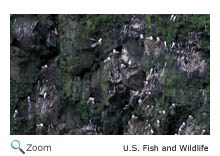 It is estimated that over 75% of the world's population of red-legged kittiwakes nest on St. George Island in the Pribilof Islands in Alaska. During the breeding season, the ledges of the island are packed with tens of thousands of kittiwakes and other nesting birds. It is estimated that over 75% of the world's population of red-legged kittiwakes nest on St. George Island in the Pribilof Islands in Alaska. During the breeding season, the ledges of the island are packed with tens of thousands of kittiwakes and other nesting birds.
|


 The red-legged kittiwake breeds in Alaska on the
Pribilof Islands, Bogoslof Islands, and Buldir Island, and on Russia's Commander Islands. It winters on the North Pacific Ocean.
The red-legged kittiwake breeds in Alaska on the
Pribilof Islands, Bogoslof Islands, and Buldir Island, and on Russia's Commander Islands. It winters on the North Pacific Ocean.



